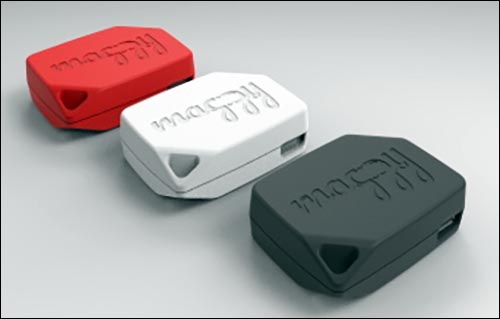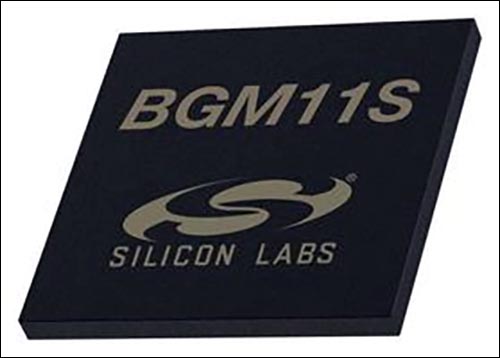Sep 09, 2020Belgian technology startup Maggy has launched a social-distancing solution leveraging Bluetooth Low Energy (BLE) 5.1 technology to provide alerts if a company's employees or visitors come within close range of one another. Maggy's wearable device comes with a built-in Silicon Labs Bluetooth system-in-package (SiP) module to capture and transmit data.
The device and related software are intended to provide a low-cost solution that can anonymously detect social-distancing breeches and alert those wearing the device, according to Ruben Miessen, Maggy's cofounder and CEO. The system can also provide a record of other Maggy devices that have been in contact with an individual who tests positive for COVID-19, and it can subsequently send an alert to those devices. Content is intended to be anonymous, Miessen says, with no identities linked to the device. In fact, privacy was a key part of the design process. Users are not required to register when using the device, he explains, and no personally identifiable data is saved.

Maggy's wearable device comes with a built-in Bluetooth SiP module.
The device is now in production and the company expects to have 50,000 units available by the end of September. The wearable is designed to be small and can be attached to a key chain, for instance. Silicon Labs' BGM13S SiP module is the smallest such module available on the market, according to Mike Silverman, the firm's global head of PR. The module captures location data via received signal strength indicators (RSSI), while Maggy's algorithms are designed to boost accuracy by filtering out false measurements.
Maggy and its solution were launched around a fast-paced design process for a competition. Miessen, who has a background in software engineering, says development began with an invitation from the European Commission's EUvsVirus Challenge hackathon in April 2020. He worked with several fellow innovators, supported by incubator company Gumption. "We started thinking about solutions," he staes. "We worked all weekend." Maggy designed the device's PCB layout and wrote its own software. "This is the first time I have built an IoT [Internet of Things] device. It's been an interesting experience."

Maggy's Ruben Miessen
The company presented a model of the solution it developed. The Hackathon had 21,000 participants. "We saw only three social-distancing devices" among the submissions, Miessen says, and Maggy was the only one using Bluetooth technology. Maggy's device won the prize, he adds, noting that the unit is smaller than other options on the market and is more energy-efficient. The team built prototypes and the product is now in production. The wearables are being produced by a third-party factory, and Maggy has received 26,000 preorders to date.
The device is priced at €40 ($46.40), and most customers are using it to manage the safety of personnel returning to work at industrial sites, logistics centers or offices. The firm also sells the product to consumers. Future versions of the Maggy unit, slated to be released in September 2020, will be able to detect any smartphone emitting a Bluetooth signal, the company reports, so that it can be used anywhere an individual goes in public. "It would also be able to detect other Bluetooth devices like smart watches," Miessen notes.
For social-distancing purposes, the device emits its BLE signal and other devices within range both send and receive signals. If the unit detects another one within close range—such as less than 2 meters (6.6 feet)—it will sound an audible alert. Moreover, it can save the ID number of the device with which it comes within close contact.
The company has released a native app for Android- and iOS-based phones, enabling contact tracing so that users can view how many people came within range of them. If a user falls ill, that person could approach his or her employer and turn in the device so that the software could prompt it to upload the IDs of other devices with which it has come in contact. The app can enable management to issue an alert to the devices, without knowing who is wearing them, indicating those individuals may have been exposed to COVID-19.
Although the system is designed to be anonymous, tags can be linked to a specific department within a company. For instance, if specific IDs are linked to the sales department, Miessen explains, "You could then see how efficient they are at enforcing social distancing." The device can be worn on a lanyard or be clipped on in order to enable a clear line of sight. Companies using the solution can acquire software to upload data from the devices.
Miessen says he sees a significant difference between this device and other social-distancing solutions. "When I look at the competition," he states, "we are one of the only social-distancing wearables based on Bluetooth." Solutions relying on smartphones fall short, he adds, since the phones' Bluetooth functionality is not accurate enough to always detect a contact without errors. What's more, phones eliminate the ability to keep the system anonymous. "People don't want on their personal device a tracker from the government," he states. "There's a huge privacy issue."

Silicon Labs' BGM13S SiP module
The Maggy wearable's location accuracy is 10 to 15 centimeters (3.9 to 5.9 inches), and its battery life is typically three or four days before recharging becomes necessary via a USB phone charger. The device comes with a gyroscope to measure whether or not it is moving, and it can be programmed to go into power-efficient mode if no movement is detected. The unit will wake up if the device moves or detects another Maggy device.
In the long term, Miessen says, the device could be used for a variety of non-COVID-19 related use cases, such as access control at events, crowd control for event or stadium managers, or mobile payments and networking. "It could be an interesting post-social-distancing device," he suggests, and could be used for a variety of purposes. If another pandemic were to occur, the social-distancing functionality could be activated.
The first 300 prototypes were release in mid-June, Miessen reports, and a manufacturing company, a gaming company and a logistics firm have each been testing the technology. "Feedback has been very positive," he says. "We're expecting a lot of mass orders." The Gumption Group is planning to deploy the system as its employees return to work in September.
The device's small form factor and low energy consumption are possible, in part, due to the BGM13S SiP module, which is designed for space-constrained applications. The SiP measures 6.5 millimeters (0.24 inch) square, according to Matt Saunders, Silicon Labs' VP of marketing and applications. Released in 2016, it can be built into fitness wearables and other devices that need to be small and offer efficient RF functionality.
When Maggy approached Silicon Labs with this project, Saunders recalls, "They had a challenging timescale. They had about a month from go-ahead to having first prototypes done. A lot of our interaction was around supporting their effort around PCB design, and our module makes big use of firmware the Maggy folks developed." The two companies trialed two different versions of Silicon Labs' modules, then selected the BGM13S that works with RSSI, plus Maggy's own algorithm.
Saunders says the SiP is designed for low battery power consumption and high RF capability. Going forward, he predicts, "I think we will see increased adoption of IoT technology in a lot more places. The move to IoT was already well under way. Adding connectivity was already in full swing [when COVID-19 arrived]. Bluetooth Low Energy and mesh [networking] are going to find a lot of applications in social distancing, asset management, building automation and certain medical applications."

